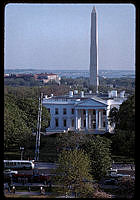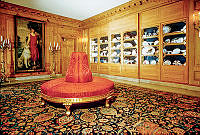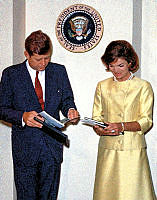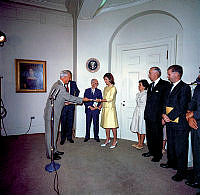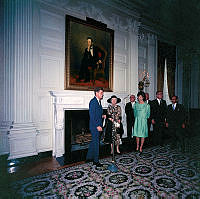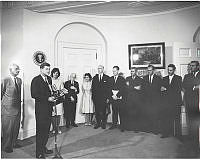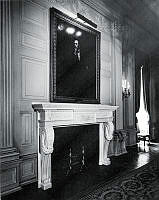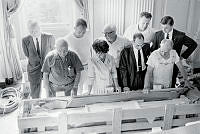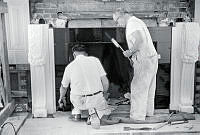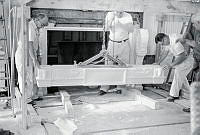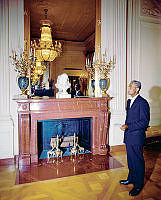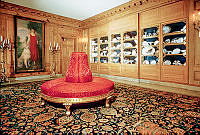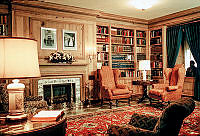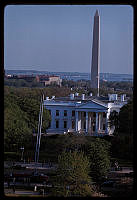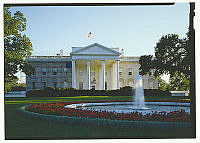Good Neighbors: FDR, Major Gist, and Blair House
Copyright © Spring 2010 White House Historical Association. All rights reserved under international copyright conventions. No part of this article may be reproduced or utilized in any form or by any means, electronic or mechanical, including photocopying, recording, or by any information storage and retrieval system, without permission in writing from the publisher. Requests for reprint permissions should be addressed to books@whha.org

Blair House front door opening on the entrance hall as it looked to the first official guests in 1942.
Blair HouseFrom its beginnings in the mid-nineteenth and into the early twentieth century, the historic preservation movement in the United States drew its leadership from private citizens, not government officials.1 An archival collection kept at Blair House, The President’s Guest House, records the pioneering alliance of Major Gist Blair, the last family descendant to live there, and President Franklin D. Roosevelt to save it from demolition by the federal government. They illuminate two political opposites whose shared passion for history transcended partisanship, saved significant architectural treasures, and produced America’s first national preservation policy in the Historic Sites Act of 1935.
In 1824 Dr. Joseph Lovell, first surgeon general of the U.S. Army, built the house today known as Blair House at 1651 Pennsylvania Avenue, NW, across from the White House, for his wife and eleven children. After Lovell’s death in 1836, the house was bought in early 1837 by Francis Preston Blair, a former circuit court clerk turned newspaper editor from Franklin County, Kentucky, who had come to Washington with his family in 1830 at President Andrew Jackson’s request to establish a pro-administration newspaper.
Blair’s insightful editorials and aggressive marketing made his paper the Globe, widely successful. Partnering with John C. Rives, he acquired a printing house and received lucrative contracts from Congress. Their publication of the proceedings of Congress in The Congressional Globe, the precursor of today’s Congressional Record, cemented Blair’s place as an influential member of Jackson’s ad hoc advisory, known as the “Kitchen Cabinet,” and continued his reputation as a respected confidant of later presidents up to and including Ulysses S. Grant. The former Lovell home soon became known as “Blair’s House” and, later, simply Blair House.2

Francis P. Blair (center) with his sons Frank (left) and Montgomery (right). Francis P. Blair purchased the house at 1651 Pennsylvania Avenue from the estate of its builder, Joseph Lovell, in 1837. Montgomery took over the house in 1855 and added the third and fourth stories. The house remained in the Blair family for more than a century.
Blair HouseBreaking with the Democrats over slavery in the Polk years, Blair and his sons Montgomery and Francis Jr. (“Frank”), both West Point graduates and lawyers in St. Louis, helped form the Republican Party and promoted Abraham Lincoln into the presidency. After the senior Blairs retired in 1845 to their Maryland farm Silver Spring (the site of the present suburb), Blair House was rented to several important officials, including the historian George Bancroft, President James K. Polk’s secretary of the navy and founder of the U.S. Naval Academy at Annapolis. Thomas Ewing, secretary of the interior under Zachary Taylor, was also a tenant; his daughter Ellen married his ward William Tecumseh Sherman in 1850 at Blair House, in a ceremony attended by President Taylor, Secretary of State Daniel Webster, and Henry Clay.3
Montgomery Blair returned to Washington, where he served variously as a judge and a lawyer, presenting cases before the Supreme Court. Later he was appointed postmaster general by President Abraham Lincoln. By that time he had taken over Blair House (in 1855) and greatly improved it, adding a third and fourth story and east wing. Following the attack on Fort Sumter, he joined his father in the small study off the front hall to offer his distant cousin Robert E. Lee command of the Union forces.
Frank Blair distinguished himself, fighting to keep Missouri a free state and as a general in Sherman’s campaigns. He ran as Horatio Seymour’s vice presidential candidate on the unsuccessful 1868 Democratic ticket and ended his political career as a Missouri senator. When his brother James died in California, his widow Mary Jesup resettled in Washington in a townhouse on Jackson Place overlooking Lafayette Park. Their sister Elizabeth defied her father by marrying navy officer Samuel Phillips Lee, a member of the large Lee family of Virginia. They moved next door to Blair House in 1859 to a row house built by her father and thereafter known as Lee House.4
A Family House
Blair House thus passed through the nineteenth century as the landmark residence of one of the capital’s prominent families. Its apparent security ended when the U.S. Senate, inspired by the approaching 1900 centennial of the federal government in Washington, established a commission to create a new vision of the city’s future. A movement thus started that was to impact Blair House as well as the rest of Washington.

Gist Blair, second row, second from right, was born in Blair House in 1860. In this c. 1880 group portrait from his college days, young Gist is surrounded by friends, possibly fraternity brothers at Princeton.
White House Historical Association/Blair HouseAn audacious plan introduced by Michigan Senator James McMillan proposed a physical transformation of the American capital. Among many changes—extending suburbs, restoring parks, expanding the National Mall—was the construction of monumental government buildings in place of the old houses that Washingtonians cherished as landmarks. The proposed alterations to Lafayette Square were radical and required demolition of Saint John’s Church and all dwellings, including the house of the Blairs.5
By this time, the house had descended in ownership jointly to the four surviving children of Montgomery Blair and his second wife Mary Woodbury Blair. Less inclined to national politics than their father and grandfather, these third generation descendants remained active in local affairs. Two of them, Minna Blair Richey and Woodbury Blair, along with their spouses, remained at Blair House with their unmarried brother Gist.6
On January 27, 1902, Minna Blair Richey accompanied her aunts Elizabeth Blair Lee and Mary Jesup Blair to the public hearings on the McMillan Plan. Astonished by what she heard, Minna Richey fired off a letter to the Senate Committee, and, following family tradition, sent a copy also to the newspaper, summarizing her family’s view of the so-called New Washington: “There would seem to be no excuse for depriving a family of their home of four generations, sacred to the associations of parents and grandparents, as well as with many events that are now a part of history.”7
Across the New York Herald, March 13, 1904, blazed the alarming headline “Plan in the Senate to Destroy Historic Homes in Washington” above photographs of the Blair House and its serene row-house neighbors, including the historic Decatur House. This news discouraged the occupants of Blair House, all weary of living together under one roof. Their attic and closets were crammed with boxes and trunks of papers and objects from past generations of a history-conscious family; walls of the rooms were lined with portraits and framed prints, while each piece of furniture had its story. When in 1912, their brother Gist Blair, 52, married Laura Lawson Ellis, the couple wished to live at Blair House, alone. After argument, the siblings agreed to settle the matter in a silent auction. Gist Blair won the property and most of the heirlooms.8

Portrait of Major Gist Blair by Ossip Perelma, 1920.
White House Historical Association/Blair HouseThe Major
Born in the house in 1860, Gist Blair literally grew up in history and was wrapped up in its romance. As a boy, sitting in his father’s Blair House study crowded with mementos, he absorbed the family lore of politics past while holding Andrew Jackson’s walking stick, looking up at the framed cartoons from the old Globe skewering Polk and Pierce; he admired Mathew Brady’s photograph of his Uncle Frank with General Sherman, and A. H. Ritchie’s engraving of his father with President Lincoln reading the Emancipation Proclamation. He had seen his father and Lincoln here, deep in conversation, lounging before the fireplace with their feet propped on the mantel. He had dined here with several presidents.
A Princeton graduate with a law degree from George Washington University, Blair balanced his career as a successful attorney and administrator of his part of the family estates with public service. He was elected president of the District of Columbia Board of Public Schools. He volunteered for World War I service as major-judge advocate in the provost marshal general’s office at the War Department across the street from Blair House gaining the courtesy title “Major” Blair.9
Blair committed himself to the role of protector of Blair House. He and Laura Blair set about redecorating it with three generations of family furnishings, to which they added purchases of antiques, over the years. Progress began to haunt them. The new federal Public Buildings Commission of 1916 continued the idea of razing buildings around Lafayette Square for government use. War intervened, but, not satisfied that the issue was tabled, Blair publicized the house over the next ten years in national and presidential history, a context intended to influence authorities through public opinion to leave Blair House undisturbed.10
Despite some media attention to the house, alterations to Lafayette Square and new federal buildings acts soon gained support. After a short business slump in 1921, a revival was in full swing by 1922 “marked, as usual in Washington, by an expansion of private building . . . Two sides of Lafayette Square changed character completely,” writes Washington historian Constance Green.11 Additionally, the Public Buildings Act of May 25, 1926, gave the secretary of the treasury approval to build more publicly-funded federal buildings in the District of Columbia. Finally, with the Act of Congress of March 1, 1929, C.416, called the Condemnation Act, the federal government was authorized to acquire property in the District, condemn structures on it, and erect buildings for its own use.12

President Franklin Delano Roosevelt at his desk in the Oval Office, by Commander Edward M. Murray, USN, 1943. The artist was a navy adviser to the president. The president appears to be sitting in a wheelchair and receiving war front news via telex machine.
Blair HouseFDR
Franklin Delano Roosevelt’s first inaugural parade broke tradition and marched down Constitution instead of Pennsylvania Avenue on wintry March 4, 1933. The century-old Blair House and its genteel peers around faded Lafayette Square stood apart from the celebration like forgotten wallflowers.
Gist contacted the new president and invited him to dinner at Blair House. They met again in November at the White House. In a subsequent letter to the major, the president referred to the need for “some kind of plan which would coordinate the broad relationship of the federal government to state and local interest in the maintenance of historic sources and places throughout the country.” Continuing, “I am struck with the fact that there is no definite, broad policy in this matter,” he asked Blair to speak with Interior Secretary Harold Ickes, “who in the transfer of governmental functions has been given authority over national monuments. Possibly legislation will be necessary to carry out any new plans.”13
Blair’s meeting with Ickes was productive. He and Blair were old friends, so the secretary, not difficult to convince, authorized funding for the Historic American Building Survey within a week. HABS was an ambitious project to document the country’s historic structures on paper and in photographs as the first step in federal commitment to their preservation.14
Hardly had this authorization taken place than Blair House faced a new, very formidable danger. The site was wanted for a new Department of State annex. Blair appealed to Roosevelt: “I little thought a few weeks ago, when you invited me to see you and asked me to make you a report on historic sites and sources I should so soon have to plead with you about the preservation of my own home, the ‘Blair House.’” He reiterated that his purpose “has been to try to preserve these things and to bring into these walls, American silver, china, and furniture—memorials of our country’s art and craftsmen—so as to try and adorn this past.” Proud that he had refused large offers to sell during the earlier speculation years, he mentioned having offered the house to the U.S. government “through Senator Lodge and Mr. Porter . . . subject to my life estate and that of my wife, to be preserved and used as a residence. ‘10 Downing Street,’ London, and ‘Checkers’ seemed good examples of such patriotic feeling.” Now doubtful of “the interest these subjects have for the average present day American,” and relieved that his offer was refused, he poignantly closed:

Blair House, 1945.
Blair House"I know from my interview with you, however, and the letter you have written me [a copy of FDR’s letter of November 10, 1933, was enclosed], that you love our dear old historic American homes and I am told your wife loves American art and craftsmen and has done much to bring it to the attention of the public. I am credibly informed a strong effort is being made to induce you to have the Government condemn the block on which my old home stands, to tear it down and to build upon the site a new State Department or Government building. I beg you to prevent this or at least give us a hearing, and I shall feel for you a gratitude more lasting and deeper than can be understood by these people."
Roosevelt comforted Blair: “I think that you can set your mind at rest in regard to your splendid house. There is no intention or prospect of buying that block—certainly at this time.”15 Over the next five years, Blair House served as one of a few examples for National Park Service officials working out the process of how to evaluate, rank, and mark sites seeking national historic designation.
The road was not always smooth. NPS historian Alvin P. Stauffer dismissed the Blairs as “at best minor leaders who never attained to truly first rank position” and “were scarcely important enough to warrant the federal government in declaring the Blair home a national historic site because the Blairs lived there.” Perhaps sensing opinion from the White House, he suggested a stronger argument based on the association of the house with Andrew Jackson, with its collections, as a representative site. Having reviewed the Stauffer report and other documents supporting the Blair House proposal, the Advisory Board determined “that the architectural value and the historical associations alone are not quite sufficient to justify its designation as a national historic site.” It also suggested, however, that, “If the house, with its present furnishings, came into the possession of the Government, and were opened to the public as a museum exemplifying National Capital life in the Jackson-Lincoln era, it would serve sufficiently useful purpose, from the historical-educational standpoint, to justify its designation as a national historic site.” This judgment reflected the fledgling historic sites program’s limited criteria and inability to recognize a significant property still privately owned and not on federal land. Thus at its fifth meeting in October 1937, the Advisory Board found Blair House to be nationally significant but did not officially make it a national historic site.16
In the spring of 1938, Blair pursued the elusive designation by again contacting his friend Secretary Ickes to request “the possibility of erecting a tablet” (an official government marker) in front of the house. Arno B. Cammerer, director, Branch of Historic Sites and Buildings, explained for the secretary that, although Blair House had been “declared to be of national significance,” the Historic Sites Act “carried no appropriation”; no funds were available for markers, but he would assist in marking the site if donated funds could be found. Meanwhile, the board urged Ickes to seek appropriations for “a uniform type of marker,” and designs were drawn up incorporating the heading “National Historic Site.” Blair’s appointment to the Advisory Board on January 3, 1939, helped Blair House become the prototype for the first official markers for recognized historic properties.17

A postcard view of Blair House as the residence of President Harry S. Truman and his family during the renovation of the White House, 1948–52.
Blair HouseThe Department of State, unfazed by the presence of the new marker, proceeded to plan for the new building. The Appropriations Act of April 5, 1941, provided for the acquisition of “land in Square 167 as a site for the State Department Annex Building.” Blair House stood on that square, with other old houses. The government acquired Lee House next door on December 1, 1941, by voluntary conveyance as a site for the annex. The remaining lots 801–808 on the west half of Square 167 plus two alleys were acquired on December 15, 1941, through condemnation proceedings. Major Gist died the next day in his beloved home.18
Percy Blair
The major bequeathed Blair House and its contents to his wife Laura, at whose death the property conveyed to his nephew, Dr. Montgomery Blair Jr., along with Blair’s hopes for its future. But it was his second cousin, Percy A. Blair, the fourth generation of the family, who took up the major’s torch and the preservation fight to the next stage. He was curator and an occupant of Anderson House, headquarters of the Society of the Cincinnati on Massachusetts Avenue. Palatial Anderson House was occasionally used by the Department of State to entertain foreign dignitaries. Working that connection with State Department officials, Percy promoted Gist’s vision of Blair House as a place for the government to welcome international guests.
America’s entry into World War II dramatically impacted the future of Blair House by diverting government priorities. President Roosevelt phased out many programs, including historic sites designation, and redeployed their personnel to the war effort. The new State Department annex proposal gained strength. Dr. Montgomery Blair Jr. compared the market value of Blair House to what the government had paid for Lee House. In the spring of 1942, with only the housekeeper left resident, Blair House went on the market for rent, furnished, or sale. Percy Blair, alarmed, continued his campaign, directing his pitch to the State Department’s protocol office. Combined with unabashed name-dropping, this effort paid off. The State Department agreed to rent Blair House for an official visit by President Manuel Prado of Peru and his staff in April 1942. Precedent for such use was thus established.19

The White House neighborhood from the west published in Leslie’s Weekly, 1898, at the beginning of the Spanish-American War, shows a parade east down Pennsylvania Avenue toward the U.S, Capitol in the distant center. The Old Executive Office Building, then housing the Army and Navy Departments, fills much of the right foreground directly across the street from Blair House, shown between the then two-story Lee House and row houses facing Lafayette Park.
Blair House, The John and Diana Zentay Collection of Historic American PrintsStill the bulldozers advanced. The State Department had no intention of surrendering its expansion plans. It was Secretary Ickes who stepped in, for he clearly had the president’s ear. In a June 9, 1942, memo to his often-marginalized Secretary of State, Cordell Hull, Roosevelt directed that a lower price be solicited from the family and that various options for purchasing the house from existing funds, even his own “Special Emergency Fund” be explored. Hull outright rejected purchasing Blair House and gave as his main reason that the asking price was too high. He also speculated that the maintenance would cause embarrassment for the government in wartime and, “Its simultaneous use as a temporary residence for distinguished foreign guests and as a historic house open to the public . . . is impracticable.” Hull finally got around to saying that plans for the “State Dept. annex” had been drawn to exclude Blair House as well as historic Decatur House, which was still a private residence on the northeast corner of the block. Finding Hull resolute, Ickes knew it was time for a firm commitment from the White House. The president’s surprisingly negative response is lost, but in essence it is preserved in a letter from Percy Blair, who had read it. “I am very sorry that the president does not feel that it is possible to acquire the house for Government purposes because we had hoped it could be used to advantage at the present time, and, as far as we can see, in the future.” Thinking the asking price of $175,000 the sticking point, he compared it to the government’s purchase price of $145,000 paid for Lee House, which was smaller and had no great collections.20
This exchange apparently triggered a rethinking by the president, who revised his decision in another memo to Hull:
"The more I think about the problem of the Blair House and the Decatur House, the more I am convinced that they should not ever be allowed to be torn down. That probably means eventual ownership by the Government. I hope you will keep this in mind and try to work out some method. Will you and Sumner [Welles] try to invent something?"

This AP story, published in 1946, renewed attention to the persistent threat of demolition of old homes to make way for a large State Department building that would occupy the entire block west of Lafayette Square. After President Roosevelt’s death in April 1945, his designation of Blair House as the nation’s official guest house seemed insufficient to protect it until President John F. Kennedy and First Lady Jacqueline Kennedy showed interest in preserving the neighborhood.
Blair HouseThus with a few words from the president, Blair House was saved. Ickes continued to facilitate negotiations among the parties over the next few days. Hull reversed himself, and at last took steps to speed the process. “My dear Mr. President . . . with regard to the Blair House . . . the appraisal value of $175,000 is exactly the asking price for the property and I feel it would be altogether practicable, with minimum structural changes and replacement of certain of the old furniture and furnishings with new materials, to provide a suitable official guest house.” Presidential pressure may not have been the only influence that made Hull change his mind. In a single revealing document in the Blair House collection, a letter to the president recommends funds be allocated “to acquire, remodel and furnish the Women’s Club building at 736 Jackson Place per agreement of the secretary of state to accommodate certain foreign officials, particularly those of non-caucasian extraction, who visit Washington as delegates to conferences, or as leaders.” A mirror of the times, it implied racial segregation was to be a feature of official hospitality.21
By fall 1942, W. E. Reynolds, commissioner of public buildings, and the Blair House heirs reached agreement on a final purchase price of $150,000, with $33,000 of that amount covering the furnishings and Americana collections that so interested President Roosevelt. Mrs. Gist Blair’s death October 8, 1942, put the process of government acquisition in high gear. On October 29, 1942, the “Order for Forthwith Surrender Of Possession” and the “Petition for Condemnation” were filed with the District Court of the United States for the District of Columbia. The U.S. government received title to Blair House on December 11, 1942, through condemnation proceedings under authority of the War Powers Act and with funds made available by the president from the National Industrial Recovery Act. Renovations by the Public Buildings Administration, predecessor of the General Services Administration (GSA), and the DOS Foreign Buildings Office were quickly completed, and the State Department officially assumed stewardship of Blair House at noon on Saturday, February 20, 1943.22
Today Blair House is supervised by four State Department offices—Protocol, Diplomatic Security, Facilities Management, and Fine Arts. They collaborate with the private nonprofit Blair House Restoration Fund to manage, protect, maintain, conserve and renew Blair House to serve the U.S. president and the American people as an elegant guest house for the use of visiting heads of state and other official guests to the United States. Through this unique diplomatic mission, Blair House has been the scene of visits and events of profound significance for more than sixty years.













